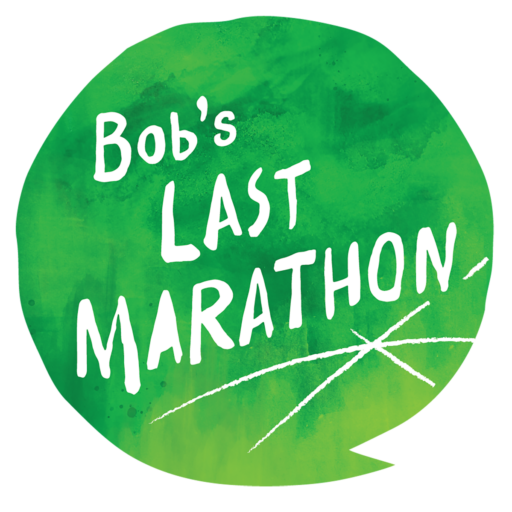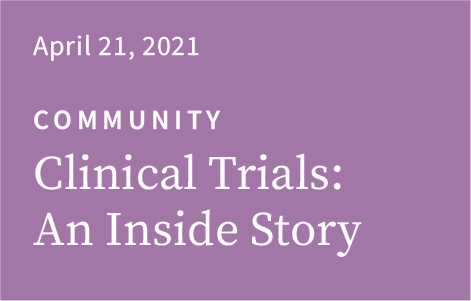Transcript
Clinical Trials: An Inside Story
My husband, Steve, and I liked to say that we hit the lottery of love when we met each other. And our love rewarded us with blessings that we embraced with joy and gratitude: two children, a home, careers that we enjoyed, a life rich in activities, the gift of our children finding wonderful partners, and, eventually, best of all, grandchildren. They were the promise that our love, DNA, and stories would continue!
To me, Steve’s goodness was the source of our bounty. Always with a smile on his face, Steve had a way of making anything seem possible. He was known for his kind and giving nature, the person people turned to for a listening ear or help with a construction project. He was a voracious reader. He loved hiking and sailing, activities he so looked forward to sharing with our grandchildren as they grew older. I also knew he would pass on his values, teaching them, just as he taught their parents, that love, honesty, and kindness were their truest, most trusted compass in life. Through his actions and words, Steve showed us that giving was a gift in itself, much more satisfying than receiving.
Can you tell he was my everything?
But everything began to change in 2011. As we watched Steve’s beautiful mother struggle through her fourth year of Alzheimer’s disease, Steve began grappling with his own cognitive issues. He would often call to tell me the bank password didn’t work, or that he’d lost his keys once again. I’d run to his office to help, only to find them in his pocket. These were just a few signs that something was wrong. But the pivotal moment came in May 2011, when Steve received a poor performance review for his job as Construction Project Manager for the Special Projects Division at Northeastern University. It was so unlike the highly competent person who handled huge projects and budgets. It was time to find out what was really going on. Five months of testing led to the diagnosis of younger-onset Alzheimer’s, just a month shy of his 59th birthday, and the beginning of the end of his 15-year career at Northeastern University.
Upon hearing the diagnosis, Steve cried, and his first thought was of our grandchildren. “I wanted to watch them grow up and play baseball,” he said. But soon, in his ever-optimistic way, Steve decided that we could be happy or sad, but the fact that we had so much love was reason enough to smile every day.
We both loved this Cheryl Strayed quote: “You don’t have a right to the cards you believe you should have been dealt. You have an obligation to play the hell out of the ones you’re holding …”
Steve and I resolved that we wouldn’t measure our remaining years in quantity, but in how we filled them. So we dug in, held each other’s hands tighter, and began walking this new road with the diagnosis strapped on like a backpack.
We found educational and socialization programs at the Alzheimer’s Association. We advocated on state and federal levels for funding for research, reducing stigma, and education for caregivers and society as a whole.
Given Steve’s nature, it was no surprise he wanted to invest our greatest asset in Alzheimer’s research—himself—by joining a clinical trial to test out drugs under investigation.
I was far less enthusiastic. If he was in the group receiving an active drug, I would worry about side effects. And even the possibility of receiving a placebo, and missing out on any benefits of a new drug, would be tough to accept. But it was Steve’s call.
Unfortunately, his particular profile didn’t match the entry requirements for clinical drug trials at that time. We would have to wait for one to open up. While we were waiting, Mass General asked us to join the Memory Study, a different type of trial called a longitudinal cohort study that does not test drugs, but gathers data by following people over a long period of time. This non-drug study was a soft entry into the world of clinical research.
The Memory Study required that Steve go through a battery of tests once a year, including brain imaging, in-depth interviews of both of us, and analysis of both blood and cerebrospinal fluid. The ultimate hope was that people would add to this data by donating their brains to research.
When asked at his first visit to consider a future brain donation, Steve said, “That’s a no-brainer, take it!” He and the doctor had a good laugh—I could already see the emotional benefit of being in this study! And the positive feelings continued: Steve truly enjoyed his visits, even the intensive brain imaging studies. While he would not be around to teach his grandchildren to sail, he would leave an important legacy for them: Giving of himself, Steve would contribute to research far beyond his time on earth.
We made the most of our visits, which became opportunities to meet with brilliant minds, compassionate clinicians, and energetic young research assistants, and to feel like we were part of a valuable team working toward a cure. And we would make a day of it, celebrating with lunch or dinner in town.
The appointments also gave us another chance to discuss what was going on with Steve, beyond the biannual visits with his neurologist. Alzheimer’s symptoms can feel subjective, and it gave me great comfort to have a sounding board to confirm that I wasn’t imagining the changes I saw in Steve. We felt closely watched, in a good way.
Steve and I arrived at each visit with the hope of hearing that the perfect clinical trial for Steve had just opened up. It took several years, but finally a drug trial opened up. The NOBLE Trial was an 18-month double-blind study; in other words, neither the participants nor doctors know who is receiving which treatment. In the end, we did find out that Steve had been taking the higher drug dose.
We looked at the study as our job, and it wasn’t always easy. The parking garage was small and we would have to drive in circles to find a spot, which would result in Steve throwing up from motion sickness, but still he persevered.
After our first day, we picked our grandsons up from school. Steve told them how happy he was to have been chosen for the trial. Five-year-old Nathan asked why Gramps would want to be in the trial and what it meant. Steve explained that people were working hard to make sure that others in the future wouldn’t get Alzheimer’s. Nathan then asked, “Gramps, will it make you get better?” Steve answered him honestly. He said, “No, it won’t make me get better, but we don’t always do things for ourselves, sometimes we do them for the good of others.”
The lesson we had never dreamt of teaching turned out to be far more valuable than the ones we had hoped to share.
Steve’s trial ended in November of 2016. The drug had not provided enough positive outcomes to justify continuing. We entered the study knowing this was a possibility, and with the belief that each “no” would eventually lead to a “yes.”
Alzheimer’s continued to deliver on its promised symptoms and steady decline, and my dearest darling broke free of the chains of this disease on April 2, 2018. Steve’s wishes were fulfilled and his brain was donated to the Mass Alzheimer’s Disease Research Center at Mass General Hospital.
I proudly proclaim that Steve left his brain to Mass General, and his heart to me. I am blessed to keep them together in my work.
Judith Johanson
MADRC Longitudinal Cohort Coordinator
Massachusetts General Hospital
Board Member, Massachusetts/New Hampshire chapter
Alzheimer’s Association

